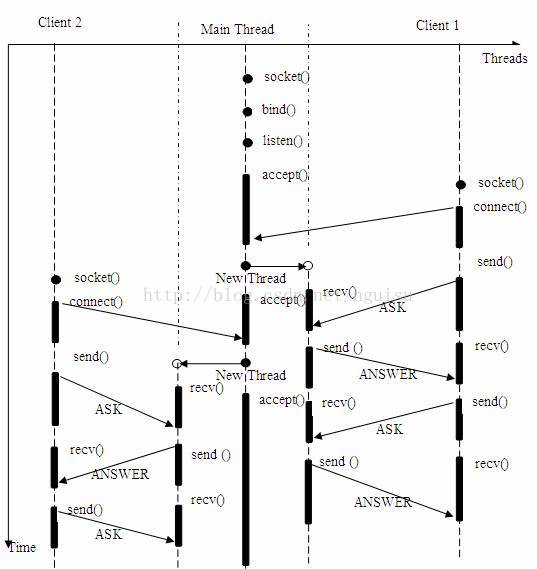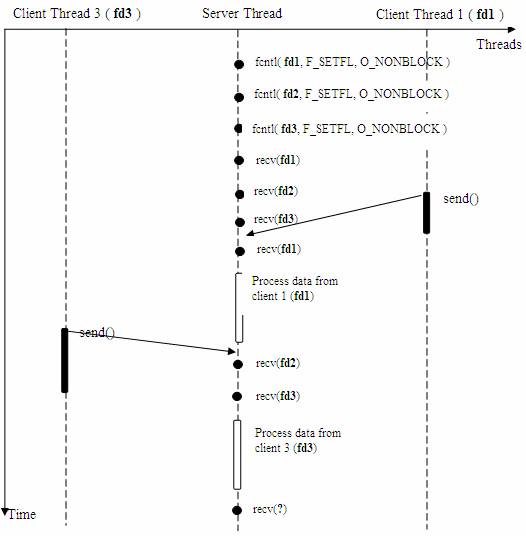三思系列:Android的消息机制,一文吃透
三思系列是我最新的学习、总结形式,着重于:问题分析、技术积累、视野拓展,关于三思系列
这次,真的可以一文吃透:
- Java层消息队列的设计
- Java层Looper分发
- Native层消息队列和Java层消息队列的关系
- Native层Looper分发
- 消息
- epoll
前言
作为Android中 至关重要 的机制之一,十多年来,分析它的文章不断,大量的内容已经被挖掘过了。所以:
- 已经对这一机制比较
熟稔的读者,在这篇文章中,看不到新东西了。 - 还不太熟悉消息机制的读者,可以在文章的基础上,继续挖一挖。
但是,经过简单的检索和分析,大部分 的文章是围绕:
- Handler,Looper,MQ的关系
- 上层的Handler,Looper、MQ 源码分析
展开的。单纯的从这些角度学习的话,并不能 完全理解 消息机制。
这篇文章本质还是 一次脑暴 ,一来 避免脑暴跑偏 ,二来帮助读者 捋清内容脉络 。先放出脑图:
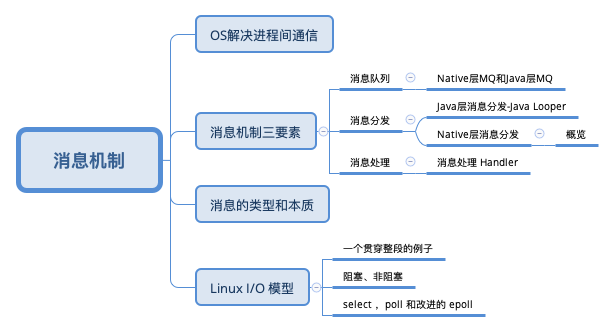
脑暴:OS解决进程间通信问题
程序世界中,存在着大量的 通信 场景。搜索我们的知识,解决 进程间通信 问题有以下几种方式:
这段内容可以泛读,了解就行,不影响往下阅读
管道
- 普通管道pipe:一种
半双工的通信方式,数据只能单向流动,而且只能在具有亲缘关系的进程间使用。- 命令流管道s_pipe:
全双工,可以同时双向传输- 命名管道FIFO:
半双工的通信方式,允许在无亲缘关系的进程间通信。消息队列 MessageQueue:
消息的链表,存放在内核中 并由消息队列标识符标识。 消息队列克服了信号传递信息少、管道只能承载无格式字节流以及缓冲区大小受限等缺点。
- 共享存储 SharedMemory:
映射一段
能被其他进程所访问的内存,这段共享内存由一个进程创建,但多个进程都可以访问。 共享内存是最快的 IPC 方式,它是针对其他进程间通信方式运行效率低而专门设计的。 往往与其他通信机制一同使用,如信号量配合使用,来实现进程间的同步和通信。
- 信号量 Semaphore:
是一个
计数器,可以用来控制多个进程对共享资源的访问。它常作为一种锁机制,防止某进程正在访问共享资源时, 其他进程也访问该资源,实现资源的进程独占。因此,主要作为进程间以及同一进程内线程间的同步手段。
- 套接字Socket:
与其他通信机制不同的是,它可以
通过网络,在不同机器之间进行进程通信。
- 信号 signal:
用于通知接收进程
某事件已发生。机制比较复杂。
我们可以想象,Android之间也有大量的 进程间通信场景,OS必须采用 至少一种 机制,以实现进程间通信。
仔细研究下去,我们发现,Android OS用了不止一种方式。而且,Android 还基于 OpenBinder 开发了 Binder 用于 用户空间 内的进程间通信。
关于 为什么不直接使用Linux中现有的进程间通信方式 ,可以看看这篇知乎问答
这篇文章 也简单探讨了 "内核空间内的消息队列"
这里我们留一个问题以后探究:
Android 有没有使用 Linux内核中的MessageQueue机制 干事情
基于消息队列的消息机制设计有很多优势,Android 在很多通信场景内,采用了这一设计思路。
消息机制的三要素
不管在哪,我们谈到消息机制,都会有这三个要素:
消息队列消息循环(分发)消息处理
消息队列 ,是 消息对象 的队列,基本规则是 FIFO。
消息循环(分发), 基本是通用的机制,利用 死循环 不断的取出消息队列头部的消息,派发执行
消息处理,这里不得不提到 消息 有两种形式:
- Enrichment 自身信息完备
- Query-Back 自身信息不完备,需要回查
这两者的取舍,主要看系统中 生成消息的开销 和 回查信息的开销 两者的博弈。
在信息完备后,接收者即可处理消息。
Android Framework中的消息队列
Android 的Framework中的消息队列有两个:
- Java层
frameworks/base/core/java/android/os/MessageQueue.java - Native层
frameworks/base/core/jni/android_os_MessageQueue.cpp
Java层的MQ并不是 List 或者 Queue 之类的 Jdk内的数据结构实现。
Native层的源码我下载了一份 Android 10 的 源码 ,并不长,大家可以完整的读一读。
并不难理解:
用户空间会接收到来自内核空间的消息, 从下图我们可知,这部分消息先被Native层获知,所以:
- 通过
Native层建立消息队列,它拥有消息队列的各种基本能力- 利用
JNI打通Java层和Native层的Runtime屏障,在Java层映射出消息队列- 应用建立在Java层之上,在Java层中实现消息的
分发和处理PS:在Android 2.3那个时代,消息队列的实现是在Java层的,至于10年前为何改成了 native实现, 推测和CPU空转有关,笔者没有继续探究下去,如果有读者了解,希望可以留言帮我解惑。

PS:还有一张经典的 系统启动架构图 没有找到,这张图更加直观
代码解析
我们简单的 阅读、分析 下Native中的MQ源码
Native层消息队列的创建:
static jlong android_os_MessageQueue_nativeInit(JNIEnv* env, jclass clazz) {
NativeMessageQueue* nativeMessageQueue = new NativeMessageQueue();
if (!nativeMessageQueue) {
jniThrowRuntimeException(env, "Unable to allocate native queue");
return 0;
}
nativeMessageQueue->incStrong(env);
return reinterpret_cast<jlong>(nativeMessageQueue);
}
很简单,创建一个Native层的消息队列,如果创建失败,抛异常信息,返回0,否则将指针转换为Java的long型值返回。当然,会被Java层的MQ所持有。
NativeMessageQueue 类的构造函数
NativeMessageQueue::NativeMessageQueue() :
mPollEnv(NULL), mPollObj(NULL), mExceptionObj(NULL) {
mLooper = Looper::getForThread();
if (mLooper == NULL) {
mLooper = new Looper(false);
Looper::setForThread(mLooper);
}
}
这里的Looper是native层Looper,通过静态方法 Looper::getForThread() 获取对象实例,如果未获取到,则创建实例,并通过静态方法设置。
看一下Java层MQ中会使用到的native方法
class MessageQueue {
private long mPtr; // used by native code
private native static long nativeInit();
private native static void nativeDestroy(long ptr);
private native void nativePollOnce(long ptr, int timeoutMillis); /*non-static for callbacks*/
private native static void nativeWake(long ptr);
private native static boolean nativeIsPolling(long ptr);
private native static void nativeSetFileDescriptorEvents(long ptr, int fd, int events);
}
对应签名:
static const JNINativeMethod gMessageQueueMethods[] = {
/* name, signature, funcPtr */
{ "nativeInit", "()J", (void*)android_os_MessageQueue_nativeInit },
{ "nativeDestroy", "(J)V", (void*)android_os_MessageQueue_nativeDestroy },
{ "nativePollOnce", "(JI)V", (void*)android_os_MessageQueue_nativePollOnce },
{ "nativeWake", "(J)V", (void*)android_os_MessageQueue_nativeWake },
{ "nativeIsPolling", "(J)Z", (void*)android_os_MessageQueue_nativeIsPolling },
{ "nativeSetFileDescriptorEvents", "(JII)V",
(void*)android_os_MessageQueue_nativeSetFileDescriptorEvents },
};
mPtr 是Native层MQ的内存地址在Java层的映射。
Java层判断MQ是否还在工作:
private boolean isPollingLocked() {
// If the loop is quitting then it must not be idling.
// We can assume mPtr != 0 when mQuitting is false.
return !mQuitting && nativeIsPolling(mPtr);
}
static jboolean android_os_MessageQueue_nativeIsPolling(JNIEnv* env, jclass clazz, jlong ptr) {
NativeMessageQueue* nativeMessageQueue = reinterpret_cast<NativeMessageQueue*>(ptr);
return nativeMessageQueue->getLooper()->isPolling();
}
/**
* Returns whether this looper's thread is currently polling for more work to do.
* This is a good signal that the loop is still alive rather than being stuck
* handling a callback. Note that this method is intrinsically racy, since the
* state of the loop can change before you get the result back.
*/
bool isPolling() const;
唤醒 Native层MQ:
static void android_os_MessageQueue_nativeWake(JNIEnv* env, jclass clazz, jlong ptr) {
NativeMessageQueue* nativeMessageQueue = reinterpret_cast<NativeMessageQueue*>(ptr);
nativeMessageQueue->wake();
}
void NativeMessageQueue::wake() {
mLooper->wake();
}
Native层Poll:
static void android_os_MessageQueue_nativePollOnce(JNIEnv* env, jobject obj,
jlong ptr, jint timeoutMillis) {
NativeMessageQueue* nativeMessageQueue = reinterpret_cast<NativeMessageQueue*>(ptr);
nativeMessageQueue->pollOnce(env, obj, timeoutMillis);
}
void NativeMessageQueue::pollOnce(JNIEnv* env, jobject pollObj, int timeoutMillis) {
mPollEnv = env;
mPollObj = pollObj;
mLooper->pollOnce(timeoutMillis);
mPollObj = NULL;
mPollEnv = NULL;
if (mExceptionObj) {
env->Throw(mExceptionObj);
env->DeleteLocalRef(mExceptionObj);
mExceptionObj = NULL;
}
}
这里比较重要,我们先大概看下 Native层的Looper是 如何分发消息 的
//Looper.h
int pollOnce(int timeoutMillis, int* outFd, int* outEvents, void** outData);
inline int pollOnce(int timeoutMillis) {
return pollOnce(timeoutMillis, NULL, NULL, NULL);
}
//实现
int Looper::pollOnce(int timeoutMillis, int* outFd, int* outEvents, void** outData) {
int result = 0;
for (;;) {
while (mResponseIndex < mResponses.size()) {
const Response& response = mResponses.itemAt(mResponseIndex++);
int ident = response.request.ident;
if (ident >= 0) {
int fd = response.request.fd;
int events = response.events;
void* data = response.request.data;
#if DEBUG_POLL_AND_WAKE
ALOGD("%p ~ pollOnce - returning signalled identifier %d: "
"fd=%d, events=0x%x, data=%p",
this, ident, fd, events, data);
#endif
if (outFd != NULL) *outFd = fd;
if (outEvents != NULL) *outEvents = events;
if (outData != NULL) *outData = data;
return ident;
}
}
if (result != 0) {
#if DEBUG_POLL_AND_WAKE
ALOGD("%p ~ pollOnce - returning result %d", this, result);
#endif
if (outFd != NULL) *outFd = 0;
if (outEvents != NULL) *outEvents = 0;
if (outData != NULL) *outData = NULL;
return result;
}
result = pollInner(timeoutMillis);
}
}
先处理Native层滞留的Response,然后调用pollInner。这里的细节比较复杂,稍后我们在 Native Looper解析 中进行脑暴。
先于此处细节分析,我们知道,调用一个方法,这是
阻塞的,用大白话描述即在方法返回前,调用者在等待。
Java层调动 native void nativePollOnce(long ptr, int timeoutMillis); 过程中是阻塞的。
此时我们再阅读下Java层MQ的消息获取:代码比较长,直接在代码中进行要点注释。
在看之前,我们先单纯从 TDD的角度 思考下,有哪些 主要场景 :当然,这些场景不一定都合乎Android现有的设计
- 消息队列是否在工作中
- 工作中,期望返回消息
- 不工作,期望返回null
- 工作中的消息队列
当前是否有消息- 不存在消息,阻塞 or 返回null?-- 如果返回null,则在外部需要需要
保持空转或者唤醒机制,以支持正常运作。从封装角度出发,应当保持空转,自己解决问题 - 存在消息
- 特殊的
内部功能性消息,期望MQ内部自行处理 - 已经到处理时间的消息, 返回消息
- 未到处理时间,如果都是排过序的,期望
空转保持阻塞or返回静默并设置唤醒? 按照前面的讨论,是期望保持空转
- 特殊的
- 不存在消息,阻塞 or 返回null?-- 如果返回null,则在外部需要需要
class MessageQueue {
Message next() {
// Return here if the message loop has already quit and been disposed.
// This can happen if the application tries to restart a looper after quit
// which is not supported.
// 1. 如果 native消息队列指针映射已经为0,即虚引用,说明消息队列已经退出,没有消息了。
// 则返回 null
final long ptr = mPtr;
if (ptr == 0) {
return null;
}
int pendingIdleHandlerCount = -1; // -1 only during first iteration
int nextPollTimeoutMillis = 0;
// 2. 死循环,当为获取到需要 `分发处理` 的消息时,保持空转
for (;;) {
if (nextPollTimeoutMillis != 0) {
Binder.flushPendingCommands();
}
// 3. 调用native层方法,poll message,注意,消息还存在于native层
nativePollOnce(ptr, nextPollTimeoutMillis);
synchronized (this) {
// Try to retrieve the next message. Return if found.
final long now = SystemClock.uptimeMillis();
Message prevMsg = null;
Message msg = mMessages;
//4. 如果发现 barrier ,即同步屏障,则寻找队列中的下一个可能存在的异步消息
if (msg != null && msg.target == null) {
// Stalled by a barrier. Find the next asynchronous message in the queue.
do {
prevMsg = msg;
msg = msg.next;
} while (msg != null && !msg.isAsynchronous());
}
if (msg != null) {
// 5. 发现了消息,
// 如果是还没有到约定时间的消息,则设置一个 `下次唤醒` 的最大时间差
// 否则 `维护单链表信息` 并返回消息
if (now < msg.when) {
// Next message is not ready. Set a timeout to wake up when it is ready.
nextPollTimeoutMillis = (int) Math.min(msg.when - now, Integer.MAX_VALUE);
} else {
// 寻找到了 `到处理时间` 的消息。 `维护单链表信息` 并返回消息
// Got a message.
mBlocked = false;
if (prevMsg != null) {
prevMsg.next = msg.next;
} else {
mMessages = msg.next;
}
msg.next = null;
if (DEBUG) Log.v(TAG, "Returning message: " + msg);
msg.markInUse();
return msg;
}
} else {
// No more messages.
nextPollTimeoutMillis = -1;
}
// 处理 是否需要 停止消息队列
// Process the quit message now that all pending messages have been handled.
if (mQuitting) {
dispose();
return null;
}
// 维护 接下来需要处理的 IDLEHandler 信息,
// 如果没有 IDLEHandler,则直接进入下一轮消息获取环节
// 否则处理 IDLEHandler
// If first time idle, then get the number of idlers to run.
// Idle handles only run if the queue is empty or if the first message
// in the queue (possibly a barrier) is due to be handled in the future.
if (pendingIdleHandlerCount < 0
&& (mMessages == null || now < mMessages.when)) {
pendingIdleHandlerCount = mIdleHandlers.size();
}
if (pendingIdleHandlerCount <= 0) {
// No idle handlers to run. Loop and wait some more.
mBlocked = true;
continue;
}
if (mPendingIdleHandlers == null) {
mPendingIdleHandlers = new IdleHandler[Math.max(pendingIdleHandlerCount, 4)];
}
mPendingIdleHandlers = mIdleHandlers.toArray(mPendingIdleHandlers);
}
// 处理 IDLEHandler
// Run the idle handlers.
// We only ever reach this code block during the first iteration.
for (int i = 0; i < pendingIdleHandlerCount; i++) {
final IdleHandler idler = mPendingIdleHandlers[i];
mPendingIdleHandlers[i] = null; // release the reference to the handler
boolean keep = false;
try {
keep = idler.queueIdle();
} catch (Throwable t) {
Log.wtf(TAG, "IdleHandler threw exception", t);
}
if (!keep) {
synchronized (this) {
mIdleHandlers.remove(idler);
}
}
}
// Reset the idle handler count to 0 so we do not run them again.
pendingIdleHandlerCount = 0;
// While calling an idle handler, a new message could have been delivered
// so go back and look again for a pending message without waiting.
nextPollTimeoutMillis = 0;
}
}
}
Java层压入消息
这就比较简单了,当消息本身合法,且消息队列还在工作中时。
依旧从 TDD角度 出发:
- 如果消息队列没有头,期望直接作为头
- 如果有头
消息处理时间先于头消息或者是需要立即处理的消息,则作为新的头- 否则按照
处理时间插入到合适位置
boolean enqueueMessage(Message msg, long when) {
if (msg.target == null) {
throw new IllegalArgumentException("Message must have a target.");
}
synchronized (this) {
if (msg.isInUse()) {
throw new IllegalStateException(msg + " This message is already in use.");
}
if (mQuitting) {
IllegalStateException e = new IllegalStateException(
msg.target + " sending message to a Handler on a dead thread");
Log.w(TAG, e.getMessage(), e);
msg.recycle();
return false;
}
msg.markInUse();
msg.when = when;
Message p = mMessages;
boolean needWake;
if (p == null || when == 0 || when < p.when) {
// New head, wake up the event queue if blocked.
msg.next = p;
mMessages = msg;
needWake = mBlocked;
} else {
// Inserted within the middle of the queue. Usually we don't have to wake
// up the event queue unless there is a barrier at the head of the queue
// and the message is the earliest asynchronous message in the queue.
needWake = mBlocked && p.target == null && msg.isAsynchronous();
Message prev;
for (;;) {
prev = p;
p = p.next;
if (p == null || when < p.when) {
break;
}
if (needWake && p.isAsynchronous()) {
needWake = false;
}
}
msg.next = p; // invariant: p == prev.next
prev.next = msg;
}
// We can assume mPtr != 0 because mQuitting is false.
if (needWake) {
nativeWake(mPtr);
}
}
return true;
}
同步屏障 barrier后面单独脑暴, 其他部分就先不看了
Java层消息分发
这一节开始,我们脑暴消息分发,前面我们已经看过了 MessageQueue ,消息分发就是 不停地 从 MessageQueue 中取出消息,并指派给处理者。
完成这一工作的,是Looper。
在前面,我们已经知道了,Native层也有Looper,但是不难理解:
- 消息队列需要
桥梁连通 Java层和Native层 - Looper只需要
在自己这一端,处理自己的消息队列分发即可
所以,我们看Java层的消息分发时,看Java层的Looper即可。
关注三个主要方法:
- 出门上班
- 工作
- 下班回家
出门上班 prepare
class Looper {
public static void prepare() {
prepare(true);
}
private static void prepare(boolean quitAllowed) {
if (sThreadLocal.get() != null) {
throw new RuntimeException("Only one Looper may be created per thread");
}
sThreadLocal.set(new Looper(quitAllowed));
}
}
这里有两个注意点:
- 已经出了门,除非再进门,否则没法再出门了。同样,一个线程有一个Looper就够了,只要它还活着,就没必要再建一个。
- 责任到人,一个Looper服务于一个Thread,这需要
注册,代表着某个Thread已经由自己服务了。利用了ThreadLocal,因为多线程访问集合,总需要考虑 竞争,这很不人道主义,干脆分家,每个Thread操作自己的内容互不干扰,也就没有了竞争,于是封装了ThreadLocal
上班 loop
注意工作性质是 分发,并不需要自己处理
- 没有
注册自然就找不到负责这份工作的人。 - 已经在工作了就不要催,催了会导致工作出错,顺序出现问题。
- 工作就是不断的取出
老板--MQ的指令--Message,并交给相关负责人--Handler去处理,并记录信息 007,不眠不休,当MQ再也不发出消息了,没活干了,大家都散了吧,下班回家
class Looper {
public static void loop() {
final Looper me = myLooper();
if (me == null) {
throw new RuntimeException("No Looper; Looper.prepare() wasn't called on this thread.");
}
if (me.mInLoop) {
Slog.w(TAG, "Loop again would have the queued messages be executed"
+ " before this one completed.");
}
me.mInLoop = true;
final MessageQueue queue = me.mQueue;
// Make sure the identity of this thread is that of the local process,
// and keep track of what that identity token actually is.
Binder.clearCallingIdentity();
final long ident = Binder.clearCallingIdentity();
// Allow overriding a threshold with a system prop. e.g.
// adb shell 'setprop log.looper.1000.main.slow 1 && stop && start'
final int thresholdOverride =
SystemProperties.getInt("log.looper."
+ Process.myUid() + "."
+ Thread.currentThread().getName()
+ ".slow", 0);
boolean slowDeliveryDetected = false;
for (;;) {
Message msg = queue.next(); // might block
if (msg == null) {
// No message indicates that the message queue is quitting.
return;
}
// This must be in a local variable, in case a UI event sets the logger
final Printer logging = me.mLogging;
if (logging != null) {
logging.println(">>>>> Dispatching to " + msg.target + " " +
msg.callback + ": " + msg.what);
}
// Make sure the observer won't change while processing a transaction.
final Observer observer = sObserver;
final long traceTag = me.mTraceTag;
long slowDispatchThresholdMs = me.mSlowDispatchThresholdMs;
long slowDeliveryThresholdMs = me.mSlowDeliveryThresholdMs;
if (thresholdOverride > 0) {
slowDispatchThresholdMs = thresholdOverride;
slowDeliveryThresholdMs = thresholdOverride;
}
final boolean logSlowDelivery = (slowDeliveryThresholdMs > 0) && (msg.when > 0);
final boolean logSlowDispatch = (slowDispatchThresholdMs > 0);
final boolean needStartTime = logSlowDelivery || logSlowDispatch;
final boolean needEndTime = logSlowDispatch;
if (traceTag != 0 && Trace.isTagEnabled(traceTag)) {
Trace.traceBegin(traceTag, msg.target.getTraceName(msg));
}
final long dispatchStart = needStartTime ? SystemClock.uptimeMillis() : 0;
final long dispatchEnd;
Object token = null;
if (observer != null) {
token = observer.messageDispatchStarting();
}
long origWorkSource = ThreadLocalWorkSource.setUid(msg.workSourceUid);
try {
//注意这里
msg.target.dispatchMessage(msg);
if (observer != null) {
observer.messageDispatched(token, msg);
}
dispatchEnd = needEndTime ? SystemClock.uptimeMillis() : 0;
} catch (Exception exception) {
if (observer != null) {
observer.dispatchingThrewException(token, msg, exception);
}
throw exception;
} finally {
ThreadLocalWorkSource.restore(origWorkSource);
if (traceTag != 0) {
Trace.traceEnd(traceTag);
}
}
if (logSlowDelivery) {
if (slowDeliveryDetected) {
if ((dispatchStart - msg.when) <= 10) {
Slog.w(TAG, "Drained");
slowDeliveryDetected = false;
}
} else {
if (showSlowLog(slowDeliveryThresholdMs, msg.when, dispatchStart, "delivery",
msg)) {
// Once we write a slow delivery log, suppress until the queue drains.
slowDeliveryDetected = true;
}
}
}
if (logSlowDispatch) {
showSlowLog(slowDispatchThresholdMs, dispatchStart, dispatchEnd, "dispatch", msg);
}
if (logging != null) {
logging.println("<<<<< Finished to " + msg.target + " " + msg.callback);
}
// Make sure that during the course of dispatching the
// identity of the thread wasn't corrupted.
final long newIdent = Binder.clearCallingIdentity();
if (ident != newIdent) {
Log.wtf(TAG, "Thread identity changed from 0x"
+ Long.toHexString(ident) + " to 0x"
+ Long.toHexString(newIdent) + " while dispatching to "
+ msg.target.getClass().getName() + " "
+ msg.callback + " what=" + msg.what);
}
msg.recycleUnchecked();
}
}
}
下班 quit/quitSafely
这是比较粗暴的行为,MQ离开了Looper就没法正常工作了,即下班即意味着辞职
class Looper {
public void quit() {
mQueue.quit(false);
}
public void quitSafely() {
mQueue.quit(true);
}
}
消息处理 Handler
这里就比较清晰了。API基本分为以下几类:
面向使用者:
- 创建Message,通过Message的
享元模式 - 发送消息,注意postRunnable也是一个消息
- 移除消息,
- 退出等
面向消息处理:
class Handler {
/**
* Subclasses must implement this to receive messages.
*/
public void handleMessage(@NonNull Message msg) {
}
/**
* Handle system messages here.
* Looper分发时调用的API
*/
public void dispatchMessage(@NonNull Message msg) {
if (msg.callback != null) {
handleCallback(msg);
} else {
if (mCallback != null) {
if (mCallback.handleMessage(msg)) {
return;
}
}
handleMessage(msg);
}
}
}
如果有 Handler callback,则交给callback处理,否则自己处理,如果没覆写 handleMessage ,消息相当于被 drop 了。
消息发送部分可以结合下图梳理:
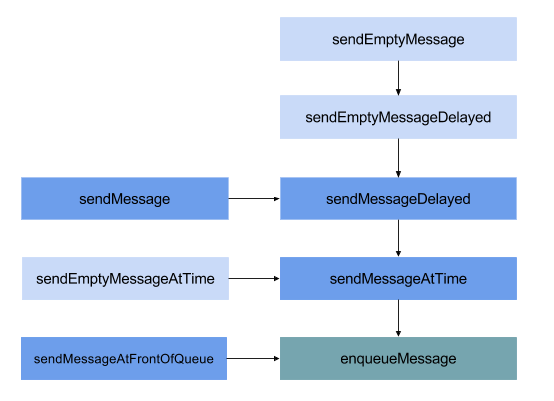
阶段性小结,至此,我们已经对
Framework层的消息机制有一个完整的了解了。 前面我们梳理了:
- Native层 和 Java层均有消息队列,并且通过JNI和指针映射,存在对应关系
- Native层 和 Java层MQ
消息获取时的大致过程- Java层 Looper 如何工作
- Java层 Handler 大致概览
根据前面梳理的内容,可以总结:从
Java Runtime看:
- 消息队列机制服务于
线程级别,即一个线程有一个工作中的消息队列即可,当然,也可以没有。 即,一个Thread至多有一个工作中的Looper。- Looper 和 Java层MQ
一一对应- Handler 是MQ的入口,也是
消息的处理者- 消息--
Message应用了享元模式,自身信息足够,满足自洽,创建消息的开销性对较大,所以利用享元模式对消息对象进行复用。
下面我们再继续探究细节,解决前面语焉不详处留下的疑惑:
- 消息的类型和本质
- Native层Looper 的pollInner
消息的类型和本质
message中的几个重要成员变量:
class Message {
public int what;
public int arg1;
public int arg2;
public Object obj;
public Messenger replyTo;
/*package*/ int flags;
public long when;
/*package*/ Bundle data;
/*package*/ Handler target;
/*package*/ Runnable callback;
}
其中 target是 目标,如果没有目标,那就是一个特殊的消息: 同步屏障 即 barrier;
what 是消息标识
arg1 和 arg2 是开销较小的 数据,如果 不足以表达信息 则可以放入 Bundle data 中。
replyTo 和 obj 是跨进程传递消息时使用的,暂且不看。
flags 是 message 的状态标识,例如 是否在使用中,是否是同步消息
上面提到的同步屏障,即 barrier,其作用是拦截后面的
同步消息不被获取,在前面阅读Java层MQ的next方法时读到过。我们还记得,next方法中,使用死循环,尝试读出一个满足处理条件的消息,如果取不到,因为死循环的存在,调用者(Looper)会被一直阻塞。
此时可以印证一个结论,消息按照 功能分类 可以分为 三种:
- 普通消息
- 同步屏障消息
- 异步消息
其中同步消息是一种内部机制。设置屏障之后需要在合适时间取消屏障,否则会导致 普通消息永远无法被处理,而取消时,需要用到设置屏障时返回的token。
Native层Looper
相信大家都对 Native层 的Looper产生兴趣了,想看看它在Native层都干些什么。
对完整源码感兴趣的可以看 这里 ,下面我们节选部分进行阅读。
前面提到了Looper的pollOnce,处理完搁置的Response之后,会调用pollInner获取消息
int Looper::pollInner(int timeoutMillis) {
#if DEBUG_POLL_AND_WAKE
ALOGD("%p ~ pollOnce - waiting: timeoutMillis=%d", this, timeoutMillis);
#endif
// Adjust the timeout based on when the next message is due.
if (timeoutMillis != 0 && mNextMessageUptime != LLONG_MAX) {
nsecs_t now = systemTime(SYSTEM_TIME_MONOTONIC);
int messageTimeoutMillis = toMillisecondTimeoutDelay(now, mNextMessageUptime);
if (messageTimeoutMillis >= 0
&& (timeoutMillis < 0 || messageTimeoutMillis < timeoutMillis)) {
timeoutMillis = messageTimeoutMillis;
}
#if DEBUG_POLL_AND_WAKE
ALOGD("%p ~ pollOnce - next message in %lldns, adjusted timeout: timeoutMillis=%d",
this, mNextMessageUptime - now, timeoutMillis);
#endif
}
// Poll.
int result = ALOOPER_POLL_WAKE;
mResponses.clear();
mResponseIndex = 0;
struct epoll_event eventItems[EPOLL_MAX_EVENTS];
//注意 1
int eventCount = epoll_wait(mEpollFd, eventItems, EPOLL_MAX_EVENTS, timeoutMillis);
// Acquire lock.
mLock.lock();
// 注意 2
// Check for poll error.
if (eventCount < 0) {
if (errno == EINTR) {
goto Done;
}
ALOGW("Poll failed with an unexpected error, errno=%d", errno);
result = ALOOPER_POLL_ERROR;
goto Done;
}
// 注意 3
// Check for poll timeout.
if (eventCount == 0) {
#if DEBUG_POLL_AND_WAKE
ALOGD("%p ~ pollOnce - timeout", this);
#endif
result = ALOOPER_POLL_TIMEOUT;
goto Done;
}
//注意 4
// Handle all events.
#if DEBUG_POLL_AND_WAKE
ALOGD("%p ~ pollOnce - handling events from %d fds", this, eventCount);
#endif
for (int i = 0; i < eventCount; i++) {
int fd = eventItems[i].data.fd;
uint32_t epollEvents = eventItems[i].events;
if (fd == mWakeReadPipeFd) {
if (epollEvents & EPOLLIN) {
awoken();
} else {
ALOGW("Ignoring unexpected epoll events 0x%x on wake read pipe.", epollEvents);
}
} else {
ssize_t requestIndex = mRequests.indexOfKey(fd);
if (requestIndex >= 0) {
int events = 0;
if (epollEvents & EPOLLIN) events |= ALOOPER_EVENT_INPUT;
if (epollEvents & EPOLLOUT) events |= ALOOPER_EVENT_OUTPUT;
if (epollEvents & EPOLLERR) events |= ALOOPER_EVENT_ERROR;
if (epollEvents & EPOLLHUP) events |= ALOOPER_EVENT_HANGUP;
pushResponse(events, mRequests.valueAt(requestIndex));
} else {
ALOGW("Ignoring unexpected epoll events 0x%x on fd %d that is "
"no longer registered.", epollEvents, fd);
}
}
}
Done: ;
// 注意 5
// Invoke pending message callbacks.
mNextMessageUptime = LLONG_MAX;
while (mMessageEnvelopes.size() != 0) {
nsecs_t now = systemTime(SYSTEM_TIME_MONOTONIC);
const MessageEnvelope& messageEnvelope = mMessageEnvelopes.itemAt(0);
if (messageEnvelope.uptime <= now) {
// Remove the envelope from the list.
// We keep a strong reference to the handler until the call to handleMessage
// finishes. Then we drop it so that the handler can be deleted *before*
// we reacquire our lock.
{ // obtain handler
sp<MessageHandler> handler = messageEnvelope.handler;
Message message = messageEnvelope.message;
mMessageEnvelopes.removeAt(0);
mSendingMessage = true;
mLock.unlock();
#if DEBUG_POLL_AND_WAKE || DEBUG_CALLBACKS
ALOGD("%p ~ pollOnce - sending message: handler=%p, what=%d",
this, handler.get(), message.what);
#endif
handler->handleMessage(message);
} // release handler
mLock.lock();
mSendingMessage = false;
result = ALOOPER_POLL_CALLBACK;
} else {
// The last message left at the head of the queue determines the next wakeup time.
mNextMessageUptime = messageEnvelope.uptime;
break;
}
}
// Release lock.
mLock.unlock();
//注意 6
// Invoke all response callbacks.
for (size_t i = 0; i < mResponses.size(); i++) {
Response& response = mResponses.editItemAt(i);
if (response.request.ident == ALOOPER_POLL_CALLBACK) {
int fd = response.request.fd;
int events = response.events;
void* data = response.request.data;
#if DEBUG_POLL_AND_WAKE || DEBUG_CALLBACKS
ALOGD("%p ~ pollOnce - invoking fd event callback %p: fd=%d, events=0x%x, data=%p",
this, response.request.callback.get(), fd, events, data);
#endif
int callbackResult = response.request.callback->handleEvent(fd, events, data);
if (callbackResult == 0) {
removeFd(fd);
}
// Clear the callback reference in the response structure promptly because we
// will not clear the response vector itself until the next poll.
response.request.callback.clear();
result = ALOOPER_POLL_CALLBACK;
}
}
return result;
}
上面标记了注意点
- 1 epoll机制,等待
mEpollFd产生事件, 这个等待具有超时时间。 - 2,3,4 是等待的三种结果,
goto语句可以直接跳转到标记处 - 2 检测poll
是否出错,如果有,跳转到 Done - 3 检测pool
是否超时,如果有,跳转到 Done - 4 处理epoll后所有的事件
- 5 处理 pending 消息的回调
- 6 处理 所有 Response的回调
并且我们可以发现返回的结果有以下几种:
- ALOOPER_POLL_CALLBACK
有 pending message 或者 request.ident 值为 ALOOPER_POLL_CALLBACK 的 Response被处理了。
如果没有:
- ALOOPER_POLL_WAKE 正常唤醒
- ALOOPER_POLL_ERROR epoll错误
- ALOOPER_POLL_TIMEOUT epoll超时
查找了一下枚举值:
ALOOPER_POLL_WAKE = -1,
ALOOPER_POLL_CALLBACK = -2,
ALOOPER_POLL_TIMEOUT = -3,
ALOOPER_POLL_ERROR = -4
阶段性小结, 我们对
消息和Native层的pollInner进行了一次脑暴,引出了epoll机制。其实Native层的
Looper分发还有不少值得脑暴的点,但我们先缓缓,已经迫不及待的要对epoll机制进行脑暴了。
##脑暴:Linux中的I/O模型
这部分内容,推荐一篇文章:使用 libevent 和 libev 提高网络应用性能——I/O模型演进变化史 作者 hguisu
PS:本段中,存在部分图片直接引用自该文,我偷了个懒,没有去找原版内容并标记出处
阻塞I/O模型图:在调用recv()函数时,发生在内核中等待数据和复制数据的过程
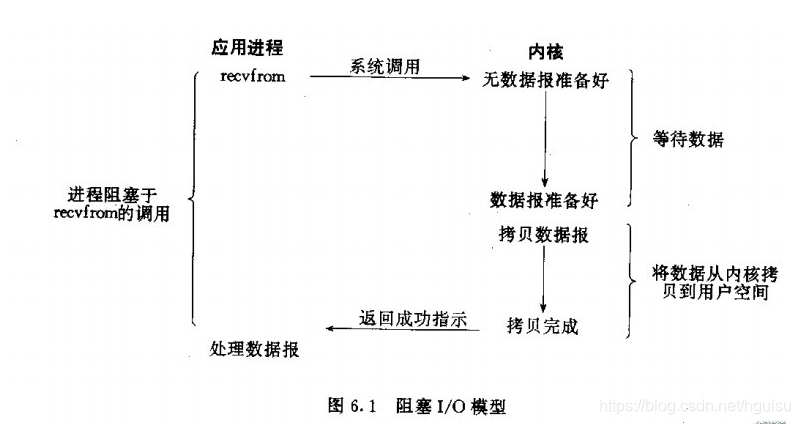
实现非常的 简单,但是存在一个问题,阻塞导致线程无法执行其他任何计算,如果是在网络编程背景下,需要使用多线程提高处理并发的能力。
注意,不要用 Android中的 点击屏幕等硬件被触发事件 去对应这里的 网络并发,这是两码事。
如果采用了 多进程 或者 多线程 实现 并发应答,模型如下:
到这里,我们看的都是 I/O 阻塞 模型。
脑暴,阻塞为调用方法后一直在等待返回值,线程内执行的内容就像
卡顿在这里。
如果要消除这种卡顿,那就不能调用方法等待I/O结果,而是要 立即返回 !
举个例子:
- 去西装店定制西装,确定好款式和尺寸后,你坐在店里一直等着,等到做好了拿给你,这就是阻塞型的,这能等死你;
- 去西装店定制西装,确定好款式和尺寸后,店员告诉你别干等着,好多天呢,等你有空了来看看,这就是非阻塞型的。
改变为非阻塞模型后,应答模型如下:
不难理解,这种方式需要顾客去 轮询 。对客户不友好,但是对店家可是一点损失都没有,还让等候区没那么挤了。
有些西装店进行了改革,对客户更加友好了:
去西装店定制西装,确定好款式和尺寸后,留下联系方式,等西服做好了联系客户,让他来取。
这就变成了 select or poll 模型:
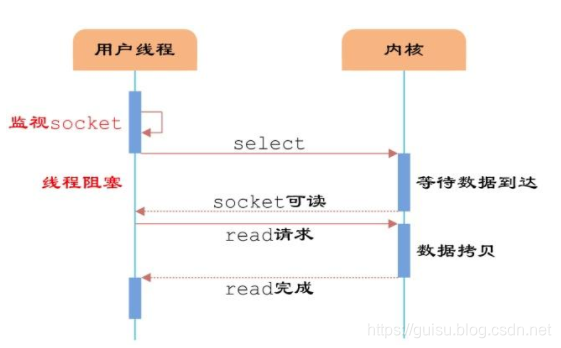
注意:进行改革的西装店需要增加一个员工,图中标识的用户线程,他的工作是:
- 在前台记录客户订单和联系方式
- 拿记录着
订单的小本子去找制作间,不断检查订单是否完工,完工的就可以提走并联系客户了。
而且,他去看订单完工时,无法在前台记录客户信息,这意味他 阻塞 了,其他工作只能先搁置着。
这个做法,对于制作间而言,和 非阻塞模型 并没有多大区别。还增加了一个店员,但是,用 一个店员 就解决了之前 很多店员 都会跑去 制作间 帮客户问"订单好了没有?" 的问题。
值得一提的是,为了提高服务质量,这个员工每次去制作间询问一个订单时,都需要记录一些信息:
- 订单完成度询问时,是否被应答;
- 应答有没有说谎;等
有些店对每种不同的考核项均准备了记录册,这和
select模型类似有些店只用一本记录册,但是册子上可以利用表格记录各种考核项,这和
poll模型类似
select 模型 和 poll 模型的近似度比较高。
没多久,老板就发现了,这个店员的工作效率有点低下,他每次都要拿着一本订单簿,去把订单都问一遍,倒不是员工不勤快,是这个模式有点问题。
于是老板又进行了改革:
- 在
前台和制作间之间加一个送信管道。 - 制作间有进度需要汇报了,就送一份信到前台,信上写着订单号。
- 前台员工直接去问对应的订单。
这就变成了 epoll模型解决了 select/poll 模型的遍历效率问题。
这样改革后,前台员工就不再需要按着订单簿从上到下挨个问了。提高了效率,前台员工只要无事发生,就可以优雅的划水了。
我们看一下NativeLooper的构造函数:
Looper::Looper(bool allowNonCallbacks) :
mAllowNonCallbacks(allowNonCallbacks), mSendingMessage(false),
mResponseIndex(0), mNextMessageUptime(LLONG_MAX) {
int wakeFds[2];
int result = pipe(wakeFds);
LOG_ALWAYS_FATAL_IF(result != 0, "Could not create wake pipe. errno=%d", errno);
mWakeReadPipeFd = wakeFds[0];
mWakeWritePipeFd = wakeFds[1];
result = fcntl(mWakeReadPipeFd, F_SETFL, O_NONBLOCK);
LOG_ALWAYS_FATAL_IF(result != 0, "Could not make wake read pipe non-blocking. errno=%d",
errno);
result = fcntl(mWakeWritePipeFd, F_SETFL, O_NONBLOCK);
LOG_ALWAYS_FATAL_IF(result != 0, "Could not make wake write pipe non-blocking. errno=%d",
errno);
// Allocate the epoll instance and register the wake pipe.
mEpollFd = epoll_create(EPOLL_SIZE_HINT);
LOG_ALWAYS_FATAL_IF(mEpollFd < 0, "Could not create epoll instance. errno=%d", errno);
struct epoll_event eventItem;
memset(& eventItem, 0, sizeof(epoll_event)); // zero out unused members of data field union
eventItem.events = EPOLLIN;
eventItem.data.fd = mWakeReadPipeFd;
result = epoll_ctl(mEpollFd, EPOLL_CTL_ADD, mWakeReadPipeFd, & eventItem);
LOG_ALWAYS_FATAL_IF(result != 0, "Could not add wake read pipe to epoll instance. errno=%d",
errno);
}
总结
相信看到这里,大家已经自己悟透了各种问题。按照惯例,还是要总结下,因为 这篇是脑暴,所以 思绪 是比较 跳跃 的,内容前后关系不太明显。
我们结合一个问题来点明内容前后关系。
Java层 Looper和MQ 会什么使用了死循环但是
不会"阻塞"UI线程/没造成ANR/依旧可以响应点击事件
- Android是基于
事件驱动的,并建立了完善的消息机制 - Java层的消息机制只是一个局部,其负责的就是面向消息队列,处理
消息队列管理,消息分发,消息处理 - Looper的死循环保障了
消息队列的消息分发一直处于有效运行中,不循环就停止了分发。 - MessageQueue的
死循环保障了Looper可以获取有效的消息,保障了Looper只要有消息,就一直运行,发现有效消息,就跳出了死循环。 - 而且Java层MessageQueue在 next() 方法中的死循环中,通过JNI调用了 Native层MQ的
pollOnce,驱动了Native层去处理Native层消息 - 值得一提的是,UI线程处理的事情也都是基于消息的,无论是更新UI还是响应点击事件等。
所以,正是Looper 进行loop()之后的死循环,保障了UI线程的各项工作正常执行。
再说的ANR,这是Android 确认主线程 消息机制 正常 且 健康 运转的一种检测机制。
因为主线程Looper需要利用 消息机制 驱动UI渲染和交互事件处理,
如果某个消息的执行,或者其衍生出的业务,在主线程占用了大量的时间,导致主线程长期阻塞,会影响用户体验。
所以ANR检测采用了一种 埋定时炸弹 的机制,必须依靠Looper的高效运转来消除之前装的定时炸弹。而这种定时炸弹比较有意思,被发现了才会炸。
在说到 响应点击事件,类似的事件总是从硬件出发的,在到内核,再进程间通信到用户空间,这些事件以消息的形式存在于Native层,经过处理后,表现出:
ViewRootImpl收到了InputManager的输入,并进行了事件处理
这里我们借用一张图总结整个消息机制流程:

图片来自 《Android7.0 MessageQueue详解》 作者 Gaugamela
PS:这篇文章写得很长,内容长,耗时也长,大约花费了10天的时间,其中还有不少内容写得未能尽兴。例如: "Java层在哪些情况下利用JNI调取Native层的唤醒,为什么这么干?"等等。
但是考虑到篇幅,决定不再往下挖了。
